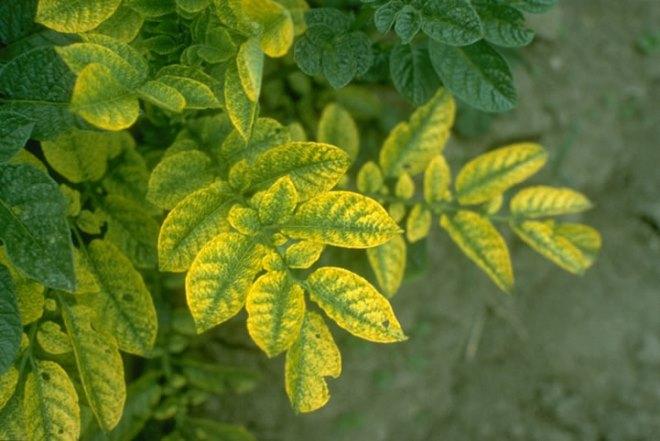
Many gardeners believe that yellowing leaves in potatoes is a normal occurrence, and do not try to find out the causes of such a change and deal with them. This is wrong, since yellow tops can be a sign of many problems that often lead to crop loss. The main reasons for this phenomenon we will consider in this article.
Content
Reasons: yellow tops of potatoes
Any person will immediately come to mind 2 reasons - diseases and pests. However, the tops can also turn yellow due to parasitic diseases, and because of the banal environmental conditions and improper care. All possible causes of the phenomenon should be studied in order to take action in time.
Humidity and temperature
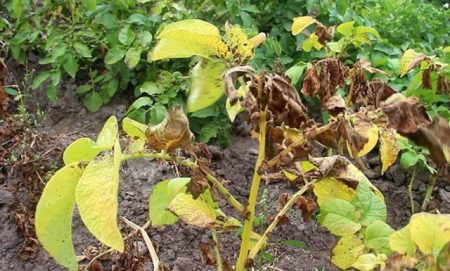
For normal root growth, a temperate climate, average temperature and high humidity are most suitable.
Most often, the lower potato leaves begin to wilt due to drought. Yellowing gradually spreads to the entire bush. At temperatures above 30 degrees, potatoes begin to die. To reduce the effect of heat on the root crop, the earth around it should be loosened in a timely manner - this will provide oxygen access. But abundant watering will not help here - they will only create a crust on the surface, which will cause the plant to “suffocate”. However, you can combine loosening and watering.
Lack of water also has a detrimental effect on potatoes: the leaves begin to turn yellow from below, and then from above, the flowers fall and the bushes simply dry out. It is recommended to adjust the irrigation system so that the soil moisture is always around 70%. During flowering, this number should be at least 75-80%.
Fertilizer shortage
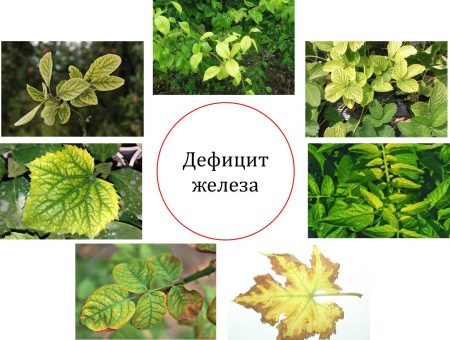
This problem is most often present in areas where potatoes are planted year after year. The earth is gradually depleted, there is a shortage of nutrients, most often - potassium and phosphorus. To replenish the reserves of these trace elements, you should fertilize the site in the fall, after harvesting. The best fertilizer in this case is nitroammophoska, which must be abundantly applied to the ground. In addition, it is worth changing the place of planting of potatoes at least once every 2-3 years, so that the soil has time to recover.
Also, the plant may turn yellow with a lack of iron and manganese. Fertilizers containing these substances should be selected and added to the potato planting sites. However, do not forget that an excess of fertilizers also negatively affects the crop.
Diseases
Often the tops begin to turn yellow due to damage to the root crop by various diseases. Consider the most common options.
Phytophthora
When yellowing the lower leaves of the bush, it is worth paying attention to the condition of the leaves. If their edges are darkened, and a fluffy coating has formed on the underside - most likely, the potato is ill with late blight. This disease leads to complete yellowing of the bush, reducing the number and size of tubers. If a disease is detected, the bushes should be treated with fungicides, for example, copper chloride. The most damaged plants are best removed from the site.
Fusarium
With this disease, the upper leaves begin to turn yellow and curl. Gradually, they begin to fall, and the stem becomes brown.However, this begins even before the leaves wilt, so when yellowness appears, it is worth making an incision in the stem: with fusarium, its inner part will already change color. Affected fruits will begin to rot during storage. The only way out is to tear out and throw away all the affected bushes.
Verticillus wilting
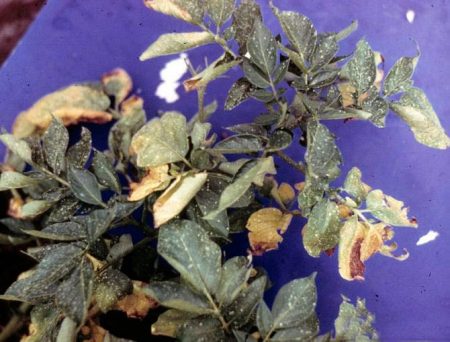
Symptoms of the disease: withering and twisting of the lower leaves, withering of young shoots, dark spots on the cut of the stem. This disease can also be controlled only by removing infected bushes. To prevent such wilting, young bushes should be treated with a solution of copper oxychloride.
Dry spotting (macrosporiosis)
Yellowed tops, elongated or rounded spots of yellowish or brown color on the leaves are the main signs of macrosporiosis. The spots are constantly increasing. The disease occurs due to a fungus and leads to complete drying of the plant, but the fruits do not develop and remain small. The method of combating fungus is treatment with special chemicals.
Ring rot
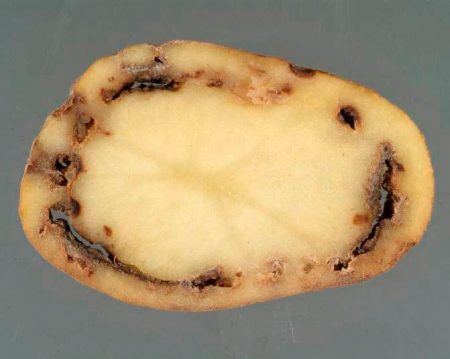
Thin stems and foliage of potatoes begin to turn yellow. Over time, they dry up and fall off. To be sure of the "diagnosis", you need to dig up and cut the tuber of the affected plant: it will have brown or yellow rings encircling the fetus near the peel. In a neglected case, the fetus will be rotten, and when compressed, it will secrete mucus. All diseased bushes should be removed, and the remaining ones should be fed with potash and nitrogen fertilizers.
Blackleg
Yellowed and curled leaves around the central vein may indicate a black leg. However, the main signs of the disease can only be seen in the tubers: they turn black and begin to rot. The roots and lower part of the stem also blacken and begin to rot. Sick bushes need to be dug up and burned, and the place where they grew should be treated with Bordeaux liquid or a mixture of ash and copper sulfate (1 liter of ash per 1 spoon of vitriol).
Pests
Potatoes are often attacked by harmful insects and worms. Here are the 2 most common types of pests.
Colorado beetle
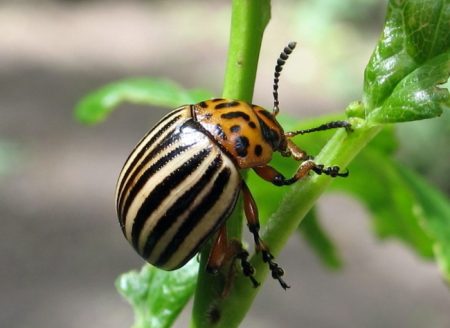
Colorado is the misfortune of many gardeners. Its presence can be determined by seeing the insect itself or its eggs - small orange grains on the leaves. Also a sign of the appearance of the pest are gnawed tops. This insect does irreparable harm by eating potato leaves - the vegetable grows slowly, does not develop and dries up.
To avoid the attack of the Colorado potato beetle, next to the potato plot you need to plant coriander, calendula, beans and tansy. You can also regularly spray the plantings with a strong infusion of mint, basil, garlic or dandelion. The strong odor of these plants repels the pest.
In case of the appearance of beetles, it is necessary to move on to serious measures. Chemical protective equipment - Mospilan, Komandor, Bankol and similar drugs. Processing with such agents should be carried out three times during the entire period of potato growth, but the latter should take place no later than 21 days before harvesting. It is also recommended that the plantings be treated with fungal or bacterial agents every week to destroy the larvae. These include Boverin and Fitoverm.
Nematodes
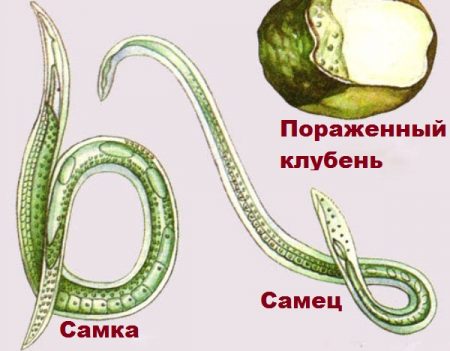
Nematodes are helminths that live in soil and feed on tubers and roots. They devour the underground portion of the potato, killing the plant. Signs of the appearance of the pest are yellowed small leaves, brown stripes in the tubers and growths on them. If there are a lot of nematodes, then quarantine should be introduced in the area: remove potatoes, treat the field with chemical agents and not use it for at least 5 years.
To avoid the appearance of nematodes, urea is introduced into the soil before planting, and sprinkled with lime after harvesting.Also, after planting, potatoes should be fertilized with liquid droppings of chickens. Near the potato plantations it is worth growing oats, peas, lupins or rye.
The bushes affected by the pest are dug up and treated with bleach. The rest of the potatoes are treated with Bazudin.
Non-parasitic diseases of potato
The third group of root diseases is non-parasitic. Let's consider them in more detail.
Lack of iron and magnesium
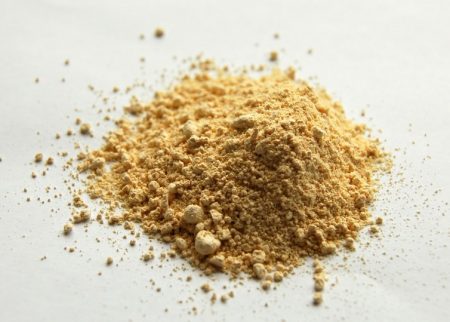
With a lack of magnesium, the lower leaves turn lighter and yellow. Such a deficit reduces yield, and the remaining tubers have little starch, which greatly affects the taste. Fighting - applying magnesium fertilizers to the soil.
With iron deficiency, the leaves also turn pale and yellow, their edges and tips darken and the leaves die. This does not affect crop yields so much, but it still harms the root crop. It will require fertilizers with iron content.
Leaf bronze
The cause of leaf bronze is the lack of potassium. It is expressed by dark green tops already at the very beginning of growth, after which the leaves become bronze, wrinkle, curl and dry. You need to deal with such a disease in its early stages by fertilizing plants with potash fertilizers. Typically, bronze occurs in peat or floodplain areas, as well as after liming. An additional risk factor is hot, dry weather.
Nitrogen deficiency
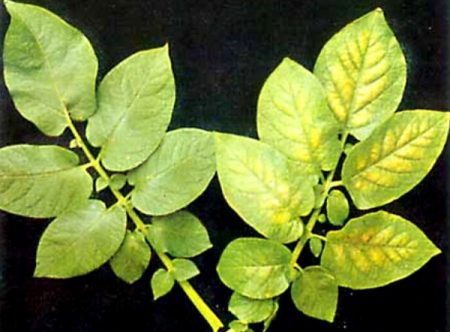
The effect on the root crop is the same: the leaves turn yellow and dry, the fruits taste worse and their yield decreases. Moreover, the foliage is small and often has an irregular shape. Nitrogen fertilizers are required. Interestingly, an excess of nitrogen also negatively affects the potato: it begins to grow very intensively, has a saturated green color, but the yield decreases.
Phosphorus deficiency
With a deficiency of phosphorus in potatoes, branching weakens, it weakens and grows slowly. A brown border appears on the tips of the lower leaves, and brown spots are visible in the tubers, from which stripes extend to the peel. This disease greatly affects the taste of potatoes and leads to rotting of the fruit. The best method of control is liming the soil.
Reviews
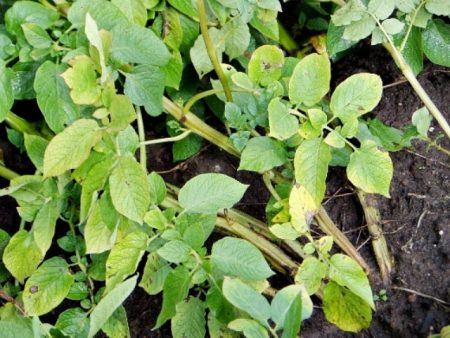
Why do potato leaves turn yellow? This question is very popular on vegetable grower forums. Let's find out what gardeners say about this problem.
Gertrude writes:
“If there was an early variety, it would have turned yellow evenly, all the bushes at once. And if the bushes of the same variety look different, then there are clearly external problems. Most often, it turns yellow due to drought. It is not the same here due to different varieties, fertilizers, etc. Or maybe a sore (mole, virus, nematodes ...). ”
Nina writes:
“Maybe the leaves turned yellow due to lack of water, especially if the summer is hot and the potatoes are poorly watered. There is only urgent watering and save. Or maybe there are too many herbicides if you fight them with weeds. And, of course, the tops turn yellow when the potatoes ripen. If it turned yellow in your autumn, then it's time to collect it. ”
Elizabeth writes:
“I remember that in 2006 all the potatoes died. It was a shame - they left the cottage, returned in a couple of weeks - and everything was already yellow ... It turned out that the Colorado had devoured. Then for 3 years they did not plant in that area, and they cultivated all the land around. So constantly inspect the beds, if the Colorado potato beetle - you must immediately begin to drive him out ... "




 Description and description of varieties in Belarus with a photo
Description and description of varieties in Belarus with a photo Do I need to pick flowers from potatoes: why do they do it
Do I need to pick flowers from potatoes: why do they do it When to dig potatoes: timing and availability of new potatoes
When to dig potatoes: timing and availability of new potatoes How to grow a good potato crop: various methods and methods, planting and care
How to grow a good potato crop: various methods and methods, planting and care
Valery
1. potatoes - NOT a root crop.
2. The lack of phosphorus does not affect the yellowing of the leaves.
3. and the first picture about chlorosis (iron deficiency) is correct, but there is no picture for comparison with chlorosis in magnesium deficiency (a hill of an unknown beige powder - what is this?).
four.from late blight leaves do not turn yellow.
5. from the nematode leaves do not turn yellow.
6. leaves do not turn yellow from the Colorado potato beetle.
In general, instead of answering a specific question - a lot of letters are about that.